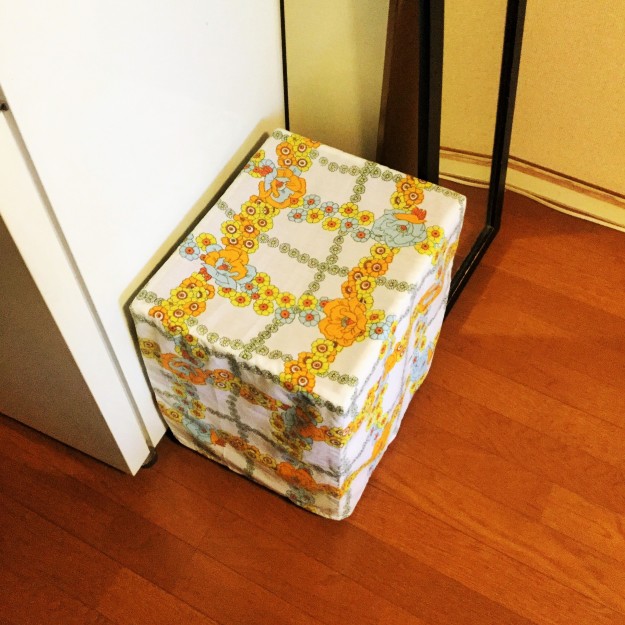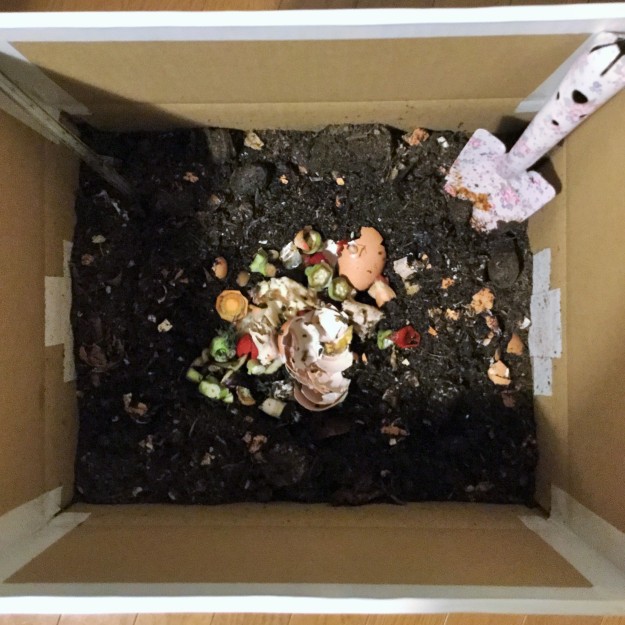
I have been composting using a cardboard box as a compost bin for about 4 months and found no trouble so far.
The composter has decomposed about 8 kilograms of kitchen scraps satisfactorily.
I wonder why, when it comes to composting indoors, almost everyone refers to vermicomposting and never to cardboard one.
Cardboard composting is very easy to handle with, no bad smells, no flies, and very little initial investment.
Everyone seems to think it is common sense that cardboard box should be IN a compost bin, but it actually works very well as a bin because it is well-ventilated. It adjusts the amount of water in the compost automatically. So you can put your kitchen scraps in it without draining.
What to prepare are:
A cardboard box with a doubled bottom
Alkali material and acid material
Something to put under the box to help ventilation (I use a small Sunoko)
Cloth to cover to prevent flies going in
For the alkali material, I use momigara-kuntanもみ殻くん炭, which is husk from rice smoked to be charcoal. Momigara-kuntan has many fine pores on its surface, which keep water, air, and microbes that decompose food put into the composter.
As for the acid material, I use bamboo powder. In the basic method of cardboard composting in Japan, they use peat moss as acid material, but peat moss is limited resource, bamboo powder is one of the sustainable alternatives. Bamboo powder contains many lactic acid bacterium and native microbes, also has many pores, and especially has a deodorant power.
If it is too difficult to prepare those 2 materials, I heard even only soil and rice bran will do (rice bran has many bacterium in it).
I put about 100g of veggie scraps and leftovers in it every day (you can put maximum 500g a day. And you can put not only veggie scraps but meat and fish unlike vermicomposter). The microbes are aerobic, so I mix the material well with a small shovel beforehand, dig a hole in the middle of the material (this is to avoid moist food scraps touching the cardboard directly), put food scraps in it, then cover it with some material. It takes about only 3 minutes or so.
This quickness owes to the factor that the composter is installed indoors. I’m a very lazy person. If this is outdoor, I can’t compost every day and my aerobic microbes wouldn’t work successfully as they actually do.
Living in a small apartment in an urban area and having no yard, I had no other choice, but now I’m very happy with this method.
As I mentioned above, vermicomposting seems to be what people consider first for indoor composting. But I was daunting. I don’t think worms are gross, of course. But I thought, I can’t be responsible for so many organisms, at least visible ones. I was also worried about runaway worms. What if I stamp them? This imagination made me terrified. At least my microbes are invisible, I feel easy at this point.
Everyday composting work is simply really fun. To my surprise, the scraps thrown in disappear completely in 2 or 3 days. And I also can feel confident that I can survive not relying on too much city convenience.
To tell the truth, at the beginning of my zero waste life, I had been lamenting that no compost service is available here, but now I’m having a second thought that I would not let others do this amusing work.
Worried about the durability of a cardboard as a zero waster?
Unless you mix materials roughly and tear the cardboard wall with a shovel, or unless you let wet things touch the cardboard, for example like tea grounds, it will be no problem. I’m thinking of using my current box for at least 3 years.
Many municipalities in Japan offer this type of composter, and even take back compost you made for their flowers at parks and sidewalks.
I highly recommend this method, if you are thinking of starting composting indoors.

